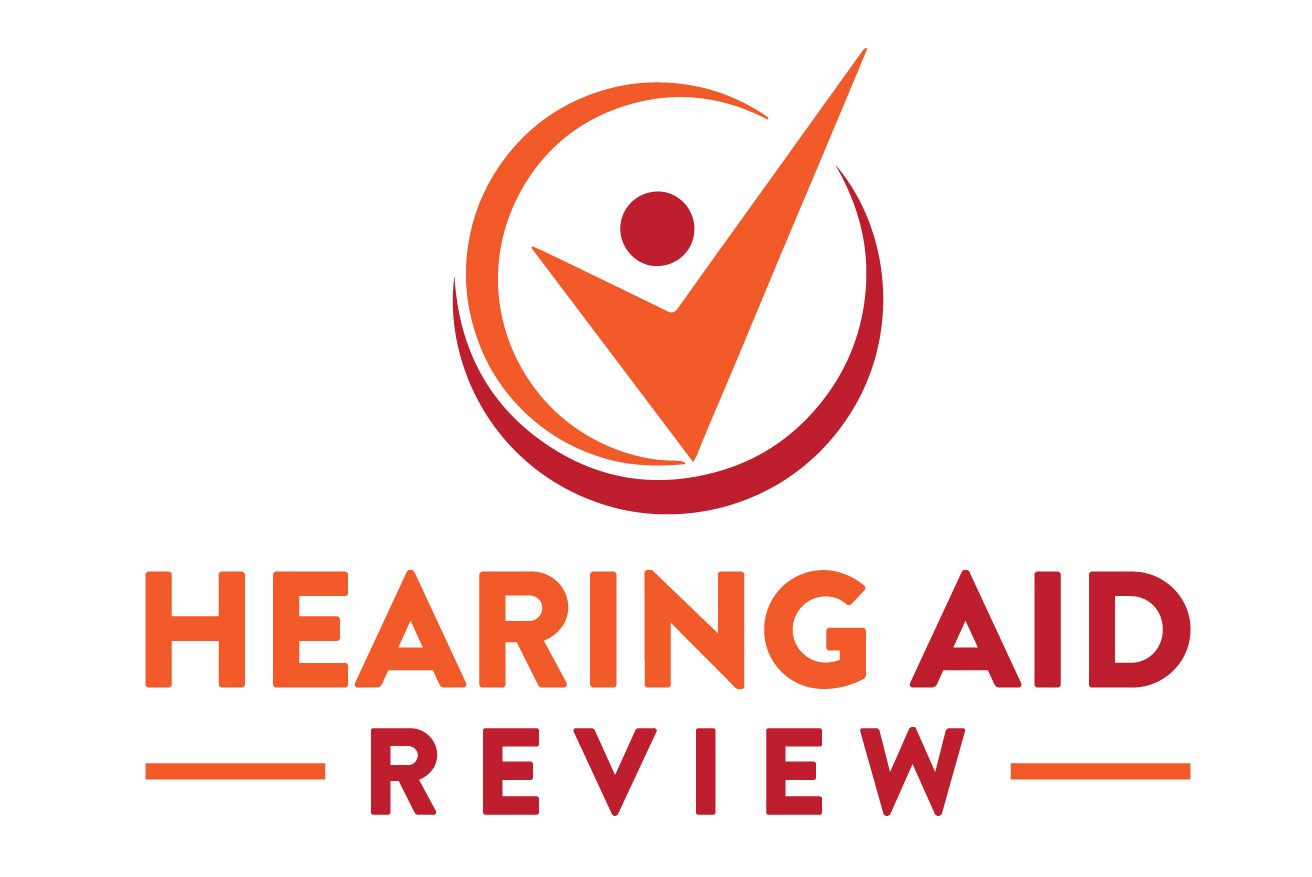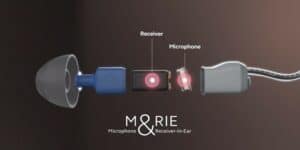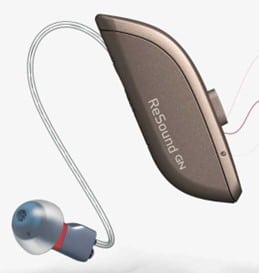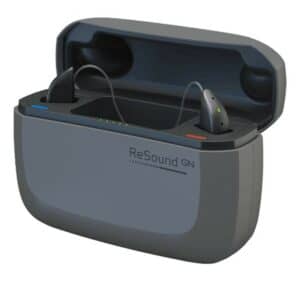Resound Omnia Tested
Resound Omnia 9 re-chargeable with M&RIE Receivers
Introduction
My hearing loss is asymmetrical. The hearing in my left ear is impaired and I have age-related hearing loss in my right ear.
I was aware of my asymmetrical hearing for decades before I started wearing hearing aids in 2016. Wearing hearing aids has improved my ability to comprehend speech, but I have difficulty knowing where sounds are coming from. I have only noticed the problem since I started wearing hearing aids, but that isn’t to say that it wasn’t there before.
Hearing aid microphones are usually situated in the body of the aid which sits behind the ear. Behind the ear might a convenient place to put the microphones, but it doesn’t seem to me to be the ideal place to put them. It might be a good place for them to pick up sounds from behind, but not for those coming from in front of you or from the side.
M&RIE Receivers
My interest in Resound hearing aids was principally with their Microphone and Receiver in Ear (M&RIE, or Marie) receivers. Most brands of RIC hearing aids have microphones only in the body of the aids.
Marie receivers have a microphone adjacent to the receiver in the tip, which picks up sounds collected by the ear lobe in the way that you would normally hear without aids.
According to Resound:
Hear the world with your own ears. The M&RIE design uses your unique ear shape to deliver our most natural sound.
That’s the hype. What about the reality?
Comfort and Fit
The body of the Omnia 9 re-chargeable aids wider than 312 battery aids, but still compact. The shape is angular, almost pointed at the top. I wondered if they might be a little uncomfortable, but they are not.
They sit comfortably behind my ears. The shape of the top guides the receiver wire neatly to the top of my ears. The wires run close to my head, making them almost invisible.
The Marie receivers are slightly larger than standard to accommodate the extra microphone. In use, the larger size receiver makes no difference to their comfort.
I used open domes for most of the evaluation period. A small dome in my left ear and size medium in the right.
It was easy enough to insert the receivers in my ears.
I was conscious of the presence of the aids at times, but they felt no different from any other aids that I have worn.
Charger and Charging
Two chargers are available, standard, and premium. They are both compact devices.
The premium charger has a battery that holds sufficient power to charge the aids three or four times.
Five lights on the premium charger indicate the state of charge of the aids.
The aids work for a long time between charges. I charged them up daily, but there was always plenty of charge left at the end of the day. They might even work for a second day if necessary.
Ease of use
Full control of the aids is possible using the smartphone app. It is easy to use and has a comprehensive set of functions, including a graphic equaliser, Find My Hearing Aid and Check My Fit functions.
The app also includes a geo-tag function that remembers the settings of your hearing aids in different places, but I didn’t use it. I want to be able to put my hearing aids in my ears and forget about them, which in the main is what I do.
I have little interest in the app. I am not comfortable with the idea of tailoring one’s life to fit around the use of a smartphone.
Volume and program changes can be made using the buttons on the aids. Notification of changes is made is by a series of beeps. The volume change beeps have no centre detent. Once the volume has been changed from the programmed setting, there is no way of knowing if you have gone back to that setting without looking at your smartphone. Other aids make a different sound to indicate the central position. I don’t find the need to change the volume very often, so it is a minor inconvenience.
Program identification is made by remembering how many beeps are associated with each program, which isn’t ideal. Widex aids have a female voice announcing the name of each program instead of beeps.
Programs
I used the All-Around program most of the time. I also used the Music program. Other programs are available for those who like to fiddle with their phones, including Restaurant, Outdoor and Front Focus.
The All-Around program worked well. I could occasionally hear the aids switch between modes in different sound environments, but it wasn’t obtrusive.
Sound Quality
The sound of the Omnia aids is excellent, as you would expect from a pair of good quality modern hearing aids. Sounds are bright and clear. Speech sounds natural and other sounds such as cutlery chinking on a plate, or a toilet flushing, are as expected. Sounds such as birdsong are natural and clear.
Speech remained clear in noisy environments, such as a busy supermarket or a hospital waiting room with an irritating TV on in the background.
Head sounds such as breathing and chewing sounded natural, as did the sound of my own voice.
Background noise is suppressed in some situations. The sound of a car engine, for instance, doesn’t sound as loud as it does with some aids. Other noises in a moving car, such as wind noise on a motorway, are not so well suppressed.
In the open, the sound of wind on the aids is well supressed.
I wondered if feedback might be a problem with the microphone in the Marie earpiece being situated close to the receiver, but it wasn’t. The Feedback Manager is very effective. There was no feedback at all in normal listening situations.
Open and closed domes with Marie receivers
I used open domes most of the time for this evaluation. The Omnia 9s performed in a similar manner to other brands of hearing aids that I have worn, with excellent sound. Speech, including my own, sounded natural and clear in most environments.
When I first put the Omnias on I felt a good sense of being present in my surroundings, which might have been down to the Marie receivers. I was unable to detect any improvement in sound spatial awareness compared with the standard RIC receivers that I usually wear.
I tried closed domes for a few days. My own voice sounded slightly louder, but apart from that their performance was similar to that of open domes. There was very little of the shut in occlusion effect that I have previously experienced with closed domes. It was quite subtle, but with the Marie receivers I found an increased sense of awareness of my surroundings both inside and outside the house.
I would have been happy to continue wearing the Omnias with Marie receivers and closed domes.
Standard (non-Marie) receivers
For comparison, I wore the Omnias with standard non-Marie receivers for a while. They didn’t sound quite as bright as the Marie receivers, which some might prefer. They still sounded excellent.
Listening to music
I tried listened to music from two sources – a hi-fi setup and a Sonos system. In each case I listened first using the All-Around program on the aids and second with the Music program. The results from the two sources were different.
Sonos speakers – Set to the All-Around program the sound was good and would probably be the setting that I would normally use. With the aids set to Music the sound was very good, with brighter treble. It was an improvement on the sound with the aids set to All-Around, but I would be happy to use either program for listening to music from Sonos speakers, or similar.
Hi-Fi system – With the aids set to the All-Around program, the sound from the speakers was somewhat lifeless and lacking in treble. With the aids set to the Music program there was more life to the sound, with brighter treble. Slight colouration of the sound was noticeable in the higher frequencies, but I have noticed that with other brands of hearing aids.
Streaming
Resound Omnia aids will stream from iPhones and Android phones. I paired the aids with my iPhone. Pairing was simple enough. There is a low level of background hiss when streaming.
Hands-free phone calls are possible with iPhones. Pressing one of the aids’ buttons takes an incoming call. The sound quality is not brilliant, but it is adequate for phone calls.
The streaming feature was useful for taking calls, but I was particularly interested in how the aids would sound with streamed music. I listened to several hi-resolution tracks using the Qobuz music streaming app.
The quality of the sound of streamed music was poor. The bass was almost non-existent, and the rest was unpleasantly tinny.
I wondered if the Marie receivers were responsible for the poor sound quality of streamed music. I listened to several tracks wearing standard receivers, but the outcome was similar. There was little or no bass and the rest sounded thin and not very nice.
For comparison I paired my Widex aids and listened to a few tracks. Widex aids use the same Bluetooth Low Energy streaming system as Resound. The Widex aids sounded much better than the Omnias, with more bass and better overall sound quality. Phonak aids, which use standard Bluetooth, sound even better.
I tried streaming music to the Omnias with closed domes to see if there would be an improvement in the sound. There was no improvement that I could detect.
Conclusion
The reason why I asked Mr Donnan if it would be possible for me to test the Omnias was that I wanted to know if the Marie receivers would help with my inability to know where sounds are coming from. I felt a good sense of being present in my surroundings, but I was not able to detect any improvement in the directionality of my hearing. I still don’t know where the blackbird that sings in my garden is hiding.
It is possible that with asymmetric hearing loss I am not likely to benefit greatly from the use of Marie receivers, but I don’t know. A person with symmetric hearing loss might experience an improvement in their spatial awareness.
My experience of using closed domes is significant. Apart from my own voice sounding slightly louder, I could detect little difference between the sound of closed and open domes. With closed domes the sound was open and clear like open domes, but a bit fuller and without an increased risk of feedback. The “shut in” occlusion effect that I have experienced with another brand of closed domes was almost non-existent. I would go so far as to say that with closed domes the Marie receivers sound like open domes but without the disadvantages.
Some people might prefer the slightly less bright sound of the standard receivers. Perhaps a first-time hearing aid wearer could start with non-Marie receivers and consider upgrading to Maries later.
Resound Omnia 9s are good quality modern hearing aids that work well in most situations and environments. Their sound quality and speech clarity in different environments is as good as others that I wear regularly. The sound quality of streamed music was not as good as the best. Many people might not consider this to be important.
With or without Marie receivers, they are excellent hearing aids. They should be included on the shortlist of anyone considering this type of hearing aid.
Personal statement
I wore and evaluated the aids and wrote this review because I am interested in hearing aid technology. I hope that you found it to be informative.
FHJ 09/09/2023
The Resound Omnia 9 Re-chargeable hearing aids were provided for me for to evaluate by Mr Robert Donnan, of RJD Hearing Care, Cleckheaton.






